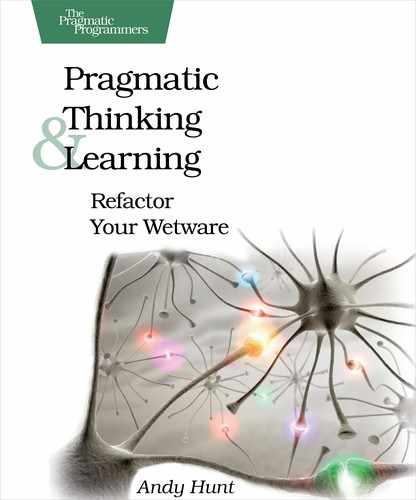Codifying Your Personality Tendencies
Hell is other people (L’enfer, c’est les autres).
➤ Jean Paul Sartre
Despite the influence of the fundamental attribution error we saw earlier, your own personality does affect your values and your perceptions, in addition to your generational affinities. This is the stuff you were born with—your own personal attitudinal context, your temperament.
You might want to think of this section in terms of buggy interfaces. It’s fine if your personal interface happens to work a certain way, but it’s dangerous to think that everyone conforms to that same interface. They don’t. They have their own interfaces to the world and may well think yours is just as odd. So, we’re going to look at major features of these interfaces and see where there might be some mismatches.
The Myers Briggs Type Indicator (MBTI) is a popular construct theory that classifies basic personality types. It’s based on the work of Carl Jung and categorizes your tendencies along four independent axes.[89] According to the MBTI, you fall somewhere on the line for each dimension, and you get a letter depending on which way you lean. Again, this isn’t a blueprint for behavior but an indication of preferences. These are the axes:
-
Extravert (E) vs. Introvert (I): Inward or outward orientation. The extravert is energized by being with people and socializing. The introvert is not; introverts are territorial and need private mental and environmental space. The introvert draws strength from solitary activities and finds social situations tiring. Seventy-five percent of the population lean to the extravert end of the scale.[90] The other twenty-five percent of us wish they’d leave us alone.
-
Sensing (S) vs. Intuition (N): How you obtain information. Of all the personality traits, this one axis is probably the largest source of miscommunication and misunderstanding. The sensing person emphasizes practicality and facts and stays firmly grounded in the details of the moment. Intuitive people are very imaginative and appreciate metaphor, are very innovative, and see many possibilities—life is always around the next corner. Intuitives may skip off to a new activity without completing any. Sensors view this as flighty; intuitives view the sensors as plodding. Seventy-five percent of folks are sensing. In this book, we’re trying to lean toward the minority and encourage more listening to your intuition.
-
Thinking (T) vs. Feeling (F): How you make decisions. Thinking people make decisions based on the rules. Feeling people evaluate the personal and emotional impact, in addition to the applicable rules. The T’s strict view of the rules may seem cold-blooded to the feeling folks. The thinking folks view the F folks as “bleeding hearts.” The population runs 50-50 on this axis, with a gender bias: more females tend to the F side and males to the T side.
-
Judging (J) vs. Perceiving (P): Your decisions are closed or left open-ended: judge quickly or keep perceiving. If you strongly favor early closure, you are a J. Js are uneasy until they have made a decision. Ps are uneasy when they have made a decision. This axis also runs about 50-50 in the general population.
Depending on which side of the fence you fall on any axis, you get that letter. The combination of the four attributes defines your temperament. For instance, an extraverted, sensing, feeling, perceiving personality is coded as ESFP. An introverted, intuitive, thinking, judging personality would be INTJ.
You can take a short test to determine your own MBTI score; various flavors are available on the Web and in the books cited.
The study of temperament types is most interesting when considering relationships between people. Strong Ns vs. strong Ss will generate friction when trying to work with each other. Strong Js and strong Ps probably shouldn’t try to hammer out a schedule together. And so it goes.
It’s probably most important to realize this: when other people react differently than you would in a given situation, they aren’t crazy, lazy, or just plain difficult. And neither are you. It doesn’t matter if you think the MBTI categorization is accurate or not: people operate based on different temperament types; it’s almost like with a different operating system, if you will, like Windows vs. Mac or vs. Linux.
There are many ways to work out a solution and compromise. The only thing that is certain not to work is to try to change the other person’s temperament to match your own. That’s a recipe for disaster. A bleeding-heart F type is not going to be convinced to ignore human suffering and just follow the rules, and a rigid T type is not going to be swayed by the drama and deviate from the rules. In either case, you’re going against the grain. You might get your way depending on the situation, but the other person sure isn’t going to like it.
You can’t change people.
This is important background information to keep in mind when collaborating with others:
They may well have a different set of bugs than you do.
| Recipe 22 | Allow for different bugs in different people. |
Think about that when constructing an argument.
| Next Actions |
-
Take a personality test. How does that compare with your co-workers and family? Do the results resonate with you or not?
-
Pretend you are the complete opposite type from yourself on each axis. What would the world look like to that kind of person? How would you interact with that person?
-
If you don’t already, hang out with people who have opposing personality types to yourself.
